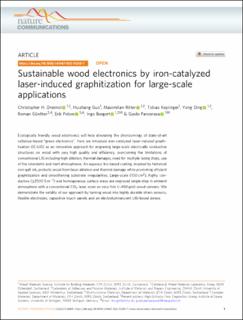Bitte benutzen Sie diese Kennung, um auf die Ressource zu verweisen:
https://doi.org/10.21256/zhaw-25238| Publikationstyp: | Beitrag in wissenschaftlicher Zeitschrift |
| Art der Begutachtung: | Peer review (Publikation) |
| Titel: | Sustainable wood electronics by iron-catalyzed laser-induced graphitization for large-scale applications |
| Autor/-in: | Dreimol, Christopher H. Guo, Huizhang Ritter, Maximilian Keplinger, Tobias Ding, Yong Günther, Roman Poloni, Erik Burgert, Ingo Panzarasa, Guido |
| et. al: | No |
| DOI: | 10.1038/s41467-022-31283-7 10.21256/zhaw-25238 |
| Erschienen in: | Nature Communications |
| Band(Heft): | 13 |
| Heft: | 3680 |
| Erscheinungsdatum: | 2022 |
| Verlag / Hrsg. Institution: | Nature Publishing Group |
| ISSN: | 2041-1723 |
| Sprache: | Englisch |
| Schlagwörter: | Wood electronics; Laser-induced graphitization |
| Fachgebiet (DDC): | 620.11: Werkstoffe |
| Zusammenfassung: | Ecologically friendly wood electronics will help alleviating the shortcomings of state-of-art cellulose-based “green electronics”. Here we introduce iron-catalyzed laser-induced graphitization (IC-LIG) as an innovative approach for engraving large-scale electrically conductive structures on wood with very high quality and efficiency, overcoming the limitations of conventional LIG including high ablation, thermal damages, need for multiple lasing steps, use of fire retardants and inert atmospheres. An aqueous bio-based coating, inspired by historical iron-gall ink, protects wood from laser ablation and thermal damage while promoting efficient graphitization and smoothening substrate irregularities. Large-scale (100 cm2), highly conductive (≥2500 S m−1) and homogeneous surface areas are engraved single-step in ambient atmosphere with a conventional CO2 laser, even on very thin (∼450 µm) wood veneers. We demonstrate the validity of our approach by turning wood into highly durable strain sensors, flexible electrodes, capacitive touch panels and an electroluminescent LIG-based device. |
| URI: | https://digitalcollection.zhaw.ch/handle/11475/25238 |
| Volltext Version: | Publizierte Version |
| Lizenz (gemäss Verlagsvertrag): | CC BY 4.0: Namensnennung 4.0 International |
| Departement: | School of Engineering |
| Organisationseinheit: | Institute of Materials and Process Engineering (IMPE) |
| Enthalten in den Sammlungen: | Publikationen School of Engineering |
Dateien zu dieser Ressource:
| Datei | Beschreibung | Größe | Format | |
|---|---|---|---|---|
| 2022_Dreimol-etal_Sustainable-wood-electronics.pdf | 2.94 MB | Adobe PDF |  Öffnen/Anzeigen |
Zur Langanzeige
Dreimol, C. H., Guo, H., Ritter, M., Keplinger, T., Ding, Y., Günther, R., Poloni, E., Burgert, I., & Panzarasa, G. (2022). Sustainable wood electronics by iron-catalyzed laser-induced graphitization for large-scale applications. Nature Communications, 13(3680). https://doi.org/10.1038/s41467-022-31283-7
Dreimol, C.H. et al. (2022) ‘Sustainable wood electronics by iron-catalyzed laser-induced graphitization for large-scale applications’, Nature Communications, 13(3680). Available at: https://doi.org/10.1038/s41467-022-31283-7.
C. H. Dreimol et al., “Sustainable wood electronics by iron-catalyzed laser-induced graphitization for large-scale applications,” Nature Communications, vol. 13, no. 3680, 2022, doi: 10.1038/s41467-022-31283-7.
DREIMOL, Christopher H., Huizhang GUO, Maximilian RITTER, Tobias KEPLINGER, Yong DING, Roman GÜNTHER, Erik POLONI, Ingo BURGERT und Guido PANZARASA, 2022. Sustainable wood electronics by iron-catalyzed laser-induced graphitization for large-scale applications. Nature Communications. 2022. Bd. 13, Nr. 3680. DOI 10.1038/s41467-022-31283-7
Dreimol, Christopher H., Huizhang Guo, Maximilian Ritter, Tobias Keplinger, Yong Ding, Roman Günther, Erik Poloni, Ingo Burgert, and Guido Panzarasa. 2022. “Sustainable Wood Electronics by Iron-Catalyzed Laser-Induced Graphitization for Large-Scale Applications.” Nature Communications 13 (3680). https://doi.org/10.1038/s41467-022-31283-7.
Dreimol, Christopher H., et al. “Sustainable Wood Electronics by Iron-Catalyzed Laser-Induced Graphitization for Large-Scale Applications.” Nature Communications, vol. 13, no. 3680, 2022, https://doi.org/10.1038/s41467-022-31283-7.
Alle Ressourcen in diesem Repository sind urheberrechtlich geschützt, soweit nicht anderweitig angezeigt.